If you’re interested in raising fighting chicken breeds for sport or personal interest, it’s important to choose the right breed.
Breeders intentionally breed fighting chickens for their aggression, territory defense, and physical prowess.
You can choose from a wide range of fighting chickens, including the powerful Game breeds and the speedy Oriental breeds.
Most see them as tiny dinosaurs. Shamo and Aseel look like dinosaurs when they fight.
In this article, we’ll look at the top 9 best fighting chicken breeds, so you can find the perfect breed to suit your needs.
What Are Fighting Chicken Breeds?
Breeders specifically bred these chicken breeds for their aggressive and territorial behavior.
They have a tendency to be more highly strung than other breeds and people sometimes use them in cockfighting, although it is illegal in most countries.
Their large and imposing physique can identify fighting chickens and their energetic and alert behavior. In most Asian countries, people keep them for cockfighting competitions, mostly in rural places.
9 Best Fighting Chicken Breeds
Below is the list of the top 9 best fighter chicken breeds:
1. Malay Game Fowl
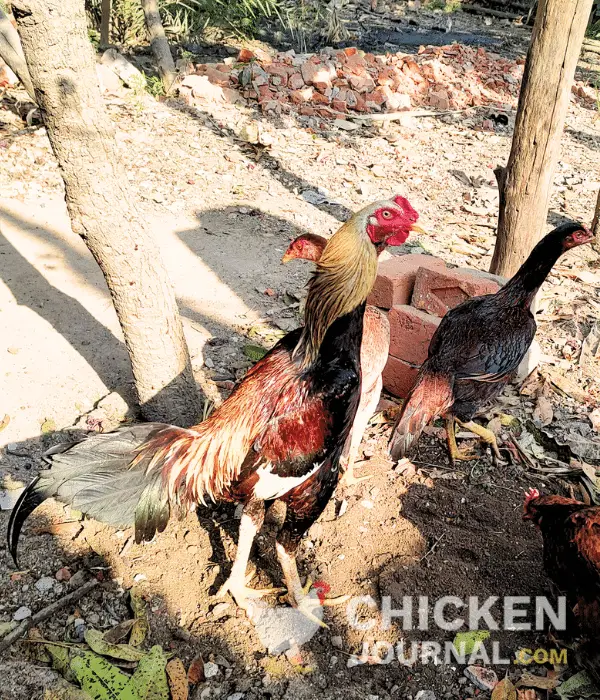
The most famous of the fighting chicken breeds, the Malay Game Fowl is an imposing breed with a large body, long neck, and aggressive attitude.
This breed is renowned for its strength and power, making it an excellent choice for cockfighting. It is also a popular breed for exhibition shows.
Handling this breed of rooster cautiously is important because of their aggressive behavior. If given a chance, they can easily become agitated and engage in fights with other chickens.
The key characteristics of the Malay Game Fowl are its large size and muscular physique.
Their head is small, with a sharp, pointy beak, while the body and legs are big and strong. Neck is long, face, and wattles are brightly colored.
The Malay Game Fowl is a highly strung chicken that can be easily agitated. They are very territorial and will fight off intruders if necessary.
This breed lays large, brown eggs. This breed grows large, with roosters weighing up to 10 pounds.
There are a few advantages to keeping Malay Game Fowl chicken. They are robust and powerful, making them excellent fighters. Their large size makes them an impressive sight.
They are good egg producers and lay large brown eggs. Their bright feathers make them attractive to admirers. They are highly territorial, so they will protect their flock.
2. Asil or Aseel Chicken

Originating in India, the Asil, or Aseel is a hardy and robust breed that has been bred for fighting for centuries.
It is one of the best fighting chicken breeds and a popular choice for cockfighting.
This breed of rooster, known for its high aggression and territorial behavior, is not suitable for novice owners. They are also very vocal and will crow throughout the day.
The Asil is large, with a long neck and muscular body. Its feathers are red and black, giving it an impressive appearance. They have a deep chest and broad shoulders; their beak is usually yellow, reddish, and blackish.
This breed is intelligent and loyal, but it can be quite aggressive. They are territorial, so keeping them separated from other chickens is important.
They lay large eggs that are usually white or cream-colored. The Asil breed grows to an average weight of 6–8 pounds.
So, Asil chickens are strong and robust, and lay large eggs. And have an attractive appearance.
3. Modern Game Fowl
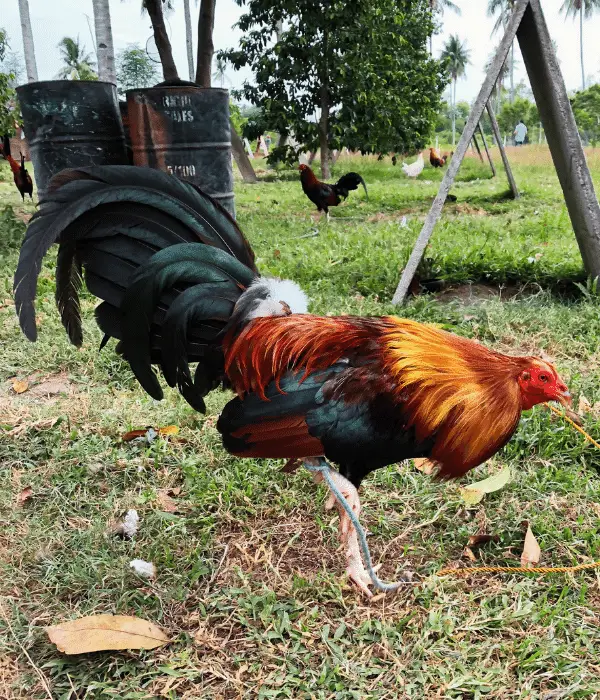
People have been breeding this breed of chicken for centuries specifically for entertainment purposes like cockfighting, making it the premier fighting breed.
This hardy bird is an active, alert fighter with a sturdy build and upright stance. Originally developed in England, it has the “game” attitude of standing up to its opponent without backing down.
The Modern Game is very heat-hardy and resilient, though they are slow to mature and be poor egg layers.
One attribute that stands out with this breed is its aggressive nature. The Modern Game is known for being territorial and will stay close to its fenced area, protecting it from predators and intruders.
The fundamental characteristics of the Modern Game are their upright stance and broad, muscular chest. They come in various colors, including black, blue, red, and white.
The rooster of this breed has a fast-paced and aggressive temperament. They are alert, active fighters, often challenging opponents to battle with little provocation.
Modern Game lays small to medium-sized eggs that are light brown. Modern Game chickens are small to medium-sized birds which weigh 5–7 pounds when fully grown.
4. American Game Fowl
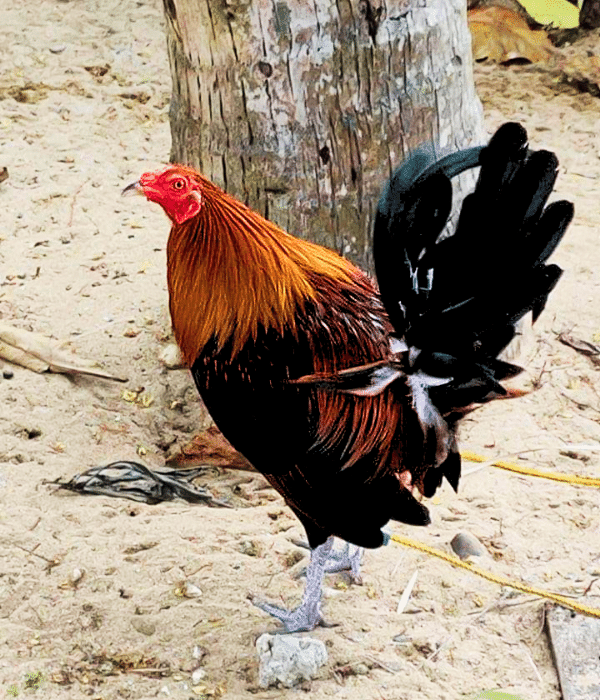
This breed is a cross between the English and Irish Game fowl. This breed has a reputation for its strong fighting ability, hardiness, and lively attitude.
Breeders developed them to perform in the ring or pit, and people frequently use them as gamecocks in organized cockfighting.
The American Game exhibits an aggressive nature and can be quite territorial. They will attack intruders and predators without hesitation.
The American Game is a medium-sized chicken with an oval body and strong, muscular legs.
They have a broad chest and upright stance, usually standing 18–20 inches tall. Colors include black, blue, red, white, and brown combinations.
The American Game has an active and aggressive temperament. They are outgoing, courageous fighters that will take on opponents without hesitation.
American Game hens typically lay medium-sized, light-brown eggs. American Game chickens are medium-sized birds weighing 6–7 pounds when fully grown.
5. Shamo Chicken
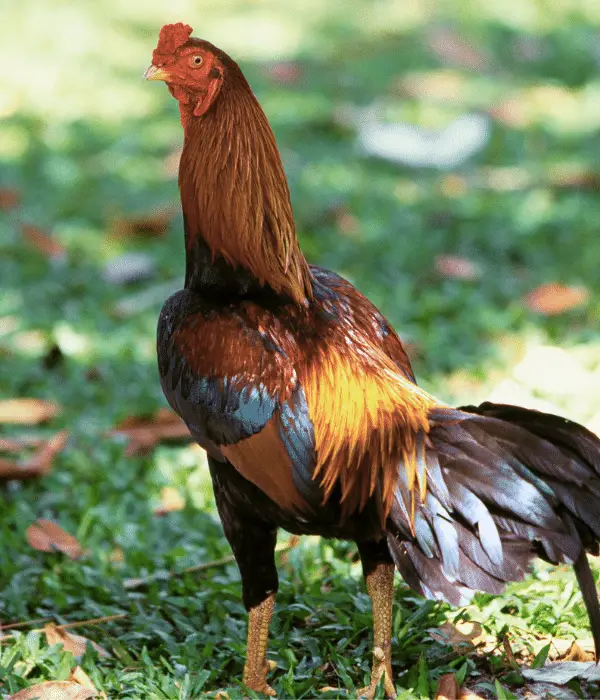
This is an ancient Japanese fighting chicken, first developed in the 1800s. It is a very intelligent bird, bred with high endurance and strength to make it a formidable opponent.
The Shamo is also very heat-hardy and can withstand extreme climates, though it does not tolerate confinement well.
This Japanese chicken is a very aggressive bird, bred to fight in sumo-style competitions. People know this Japanese chicken for its high aggression and how it will attack almost anything it sees as a threat.
The main physical characteristics of the Shamo are its long, slender body, and thick feathers. It has a broad chest with a long neck and legs and a short, curved beak. The Shamo has black or dark-brown feathers with occasional red and white markings.
People know the Shamo breed for its aggressive temperament. However, with proper training and socialization, it can be a loyal pet that is good for children.
Shamo chicken is a relatively good layer of large, white eggs. Additionally, it can serve as a dual-purpose bird and produce a decent amount of meat.
This breed of chicken is relatively large, with roosters reaching 8 pounds and hens up to 6 pounds.
There are a few good reasons to keep the Shamo chicken breed. They are highly intelligent, making it easy to train.
Shamo chickens are very heat-hardy and can withstand extreme climates. Shamo chickens produce large, white eggs.
Also, they are dual-purpose birds, produce a decent amount of meat
6. Old English Game
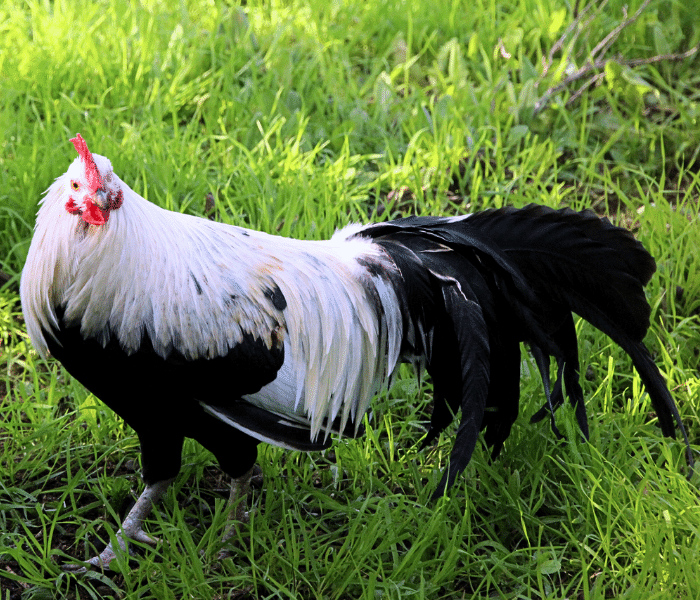
The breed has existed since the 1600s. They have a game cock appearance and are bold, fearless fighters in the ring.
The Old English Game, the chicken, is a good choice for those looking for an aggressive fighter.
The birds have long, pointed tails, and deep chests and are broad-backed. These birds also possess long, powerful spurs.
The Old English Game, the chicken, is an aggressive breed that can be quite territorial in defending its territory.
They will use their spurs and claws to fight off rival birds and protect their flock. The Old English Game is tenacious in battle, but breeding it for fighting can lead to excessive aggression.
The Old English Game is a medium-sized breed with a deep chest, long tail, and broad back. These birds have an upright stance and can reach heights of up to 18 inches.
They are usually light-brown with white markings, although some varieties may have black or blue-tinged feathers.
The Old English Game is a brave and fierce breed that can be quite aggressive when provoked.
They are docile and good-natured, but can turn aggressive when threatened.
They may also fight with other birds in the flock, so monitoring them is important.
The Old English Game is an average layer, producing around three eggs per week. The eggs are usually light brown or cream-colored and can vary in size.
This breed has a medium size and can reach heights up to 18 inches. They are also relatively lightweight and can range from 3 to 6 pounds.
The Old English Game Breed is a good breed of chicken. They are a brave and fierce breed, good at defending their territory.
Not only this, they are an average egg layer with light-brown or cream-colored eggs. The Old English Game chicken has a good-natured and docile temperament.
7. Sumatra Chicken
Sumatra is a large breed of fighting chicken that originated in Indonesia. People know them for their formidable size, strength, and courage.
The Sumatra has a distinctive appearance, characterized by its tall stance, long legs, large combs, and long back feathers.
The Sumatra is an aggressive breed that can quickly become territorial and will use its spurs and claws to defend itself. It is a tough and strong opponent.
The Sumatra has a tall, upright stance, long legs, and large combs. The feathers are usually black or dark green, and the hens may also sport white neck feathers.
Generally, the Sumatra breed is its bravery and fearlessness characterizes good-natured. However, if their territory or flock is threatened, they can become aggressive.
The Sumatra is a decent egg layer, producing up to three weekly eggs. The eggs are usually white or light brown and can range from small to large.
The Sumatra is a large breed of chicken, reaching heights of up to 30 inches and weighing 6–8 pounds.
The Sumatra Breed has many advantages. They are popular for their size, strength, and courage. Distinctive appearance with long legs, large combs, and long tail feathers are other specialties.
8. Indian Game Chicken
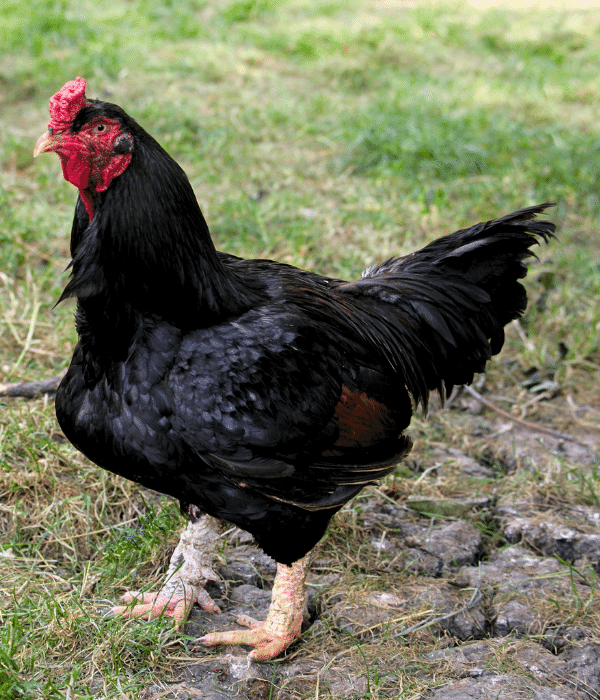
The Indian Game fowl is another popular breed of fighting chicken. People originated the Indian Game fowl breed in India and used it as a game bird for centuries.
Poultry lovers mostly recognize it for its stocky, muscular body and powerful wings and claws. They mostly use them as a meat chicken.
The Indian Game chicken is highly aggressive. It will run toward outsiders and peck at them. It is an easy-to-tame breed.
Keeping the Indian Game fowl near other chickens is not recommended. They are rarely friendly in nature and start pecking and fighting just after 3–4 weeks.
They are heavy birds with muscular bodies. Indian Game fowl has wide and thick legs.
Both the hen and roosters are not fluffy and have tight feathering. The hens of this breed lay around 60-90 light brown eggs per year.
Also, the hens go broody and take care of their chicks very well. The average weight of Indian Game chicken is around 7.6 lbs for.
9. Kelso Game Fowl
The Kelso Game fowl is one of the most popular fighting chicken breeds. It was developed from various American Game fowl breeds developed by the famous American breeder, Walter A. Kelso.
This is an aggressive breed that guards its territory. Its quick temperament makes it good in rooster fighting. They lay cream-like eggs and grow to an average weight of 4 pounds.
They have white or yellow legs and a pea or straight comb. Kelso Game fowl are usually black breasted reds (ranging from deep mahogany to light reds).
The Kelso Game fowl fighting rooster is one of the most popular and common rooster breeds used in cockfighting. The hen of this breed lay around 100–120 eggs per year.
They are not egg-laying breeds. But yes, people use them for meat. They fully mature after 6 months of age.
Kelso breed possesses extreme intelligence, earning them the reputation of being smart fighters. The average weight of Kelso Game Fowl rooster is about 8 lbs, and hens weigh around 6 lbs.
Fighting Chicken vs. Docile Chicken
Fighting chickens and docile chickens are two different types of chickens that differ greatly from each other.
- Breeders breed fighting chickens for cockfighting because of their aggressive behavior, while they breed docile chickens for their meat or egg-laying capabilities.
- Fighting chickens is larger and stronger than docile chickens, which gives them an advantage in fights. They also have sharp spurs on their legs that are used for defense. On the other hand, docile chickens are smaller and less physically imposing, but they are mostly calmer and less likely to become aggressive.
- Farmers typically isolate fighting chickens from other chickens, while they usually keep docile chickens in flocks and are much more social. Fighting chickens become more aggressive when kept in isolation, affecting their behavior. In contrast, docile chickens are typically more docile and less likely to fight because of their socialization with other chickens.
- People train and condition fighting chickens to fight, often through physical and psychological means, while they do not train or condition docile chickens for aggression.
- People often use fighting chickens for sport and entertainment, while they use docile chickens for meat production and their eggs.
Major Problems With Raising Fighting Chicken Breeds
There are several significant problems you may face with raising fighting chicken breeds:
Ethical concerns: Raising birds for fighting goes against the ethical principles of animal welfare and is inhumane. Many consider it cruel to subject birds to aggressive and violent behavior, which can cause physical harm and psychological stress.
Legal issues:
Raising fighting chickens is illegal in many countries and can lead to serious punishments like imprisonment, fines, and the seizure of birds and equipment. Some countries also consider possessing fighting birds a criminal offense.
Health problems: Fighting chickens frequently experience extreme physical stress, which can lead to the development of serious health issues such as infections, wounds, and muscle damage. They are also often fed an improper diet to increase aggression, which can further compromise their health.
Disease transmission: Close confinement of fighting chickens can facilitate the transmission of diseases, which can spread quickly and cause significant harm to the birds.
Financial cost: Raising fighting chickens can be expensive because of the cost of breeding, feeding, and caring for the birds, as well as acquiring the equipment and facilities necessary for training and fighting.
In addition, the illegal nature of the activity means that participants may face additional costs associated with legal fees and penalties.
FAQs on Fighting Chicken Breeds
Where is chicken fighting legal?
Chicken fighting is illegal in many countries and is animal cruelty. Chicken fighting is illegal in the United States under the Animal Welfare Act, and those who engage in it can face fines and imprisonment. Despite its illegality, this cultural tradition is still prevalent in countries such as the Philippines.
Why do chickens fight each other?
Chickens are naturally social animals and establish a hierarchy within their flock known as the pecking order. When two chickens challenge each other for dominance, they engage in physical combat, known as chicken fighting. These fights can occur between roosters, a rooster, and a dominant hen.
How to breed fighting chickens?
It is illegal and unethical to breed chickens for fighting purposes. The breeding of fighting chickens involves selective breeding and training, which can cause physical and psychological harm to the birds.
If you are interested in keeping chickens as pets or for egg production, it is advisable to adopt them from a reputable source that does not condone animal cruelty.
How much does fighting chickens cost?
Purchasing or selling chickens for fighting is illegal, so there is no established market price. Chickens for pets or egg production usually range in price from $5 to $20 per bird.
How to stay safe from the spurs of fighting chickens?
Taking precautions when handling chickens is important to avoid being injured by their sharp spurs. When handling a chicken, hold it securely by its legs and avoid grabbing it by the wings.
Wear gloves if necessary, and be cautious when handling roosters, as they are more likely to use their spurs in self-defense. It is also recommended to avoid reaching near their spurs when handling birds, as they can quickly kick out and cause injury.
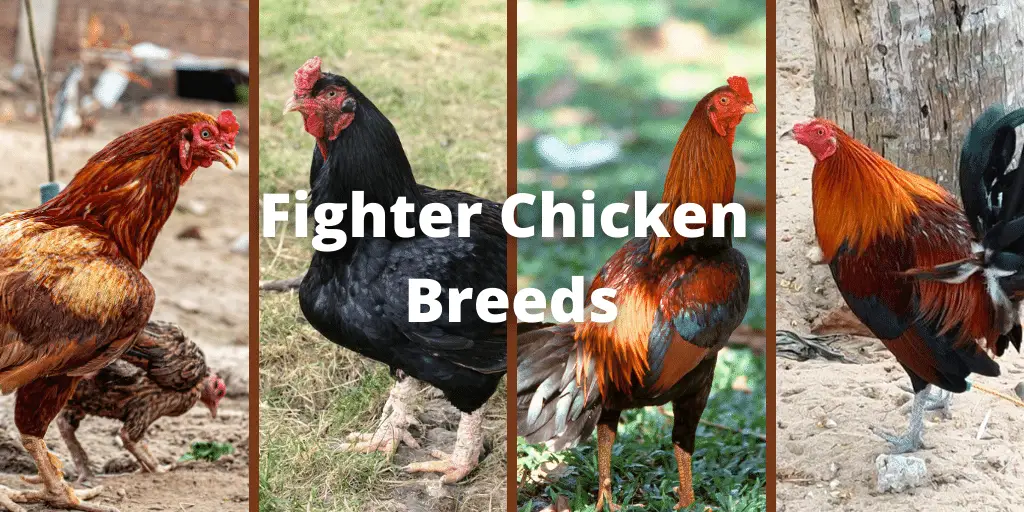
Why the HELL would you encourage this cruel blood sport by publishing such article. There is something seriously wrong with you
We have already mentioned all the links and laws about chicken fighting in this article. This article does not encourage people to involve in chicken fighting.
But yes, these game fowls are available all over the world and people must know what are the game fowls which fight a lot. So that people manage them in proper way.